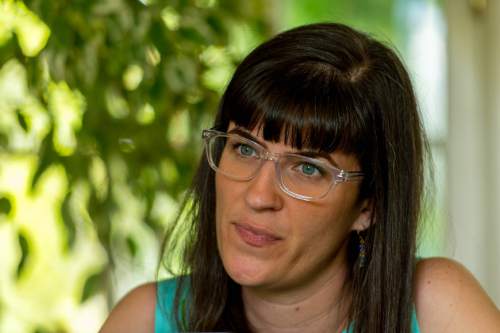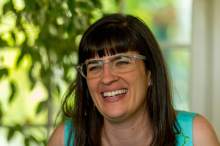This is an archived article that was published on sltrib.com in 2016, and information in the article may be outdated. It is provided only for personal research purposes and may not be reprinted.
June 23, 2014. Surely, this would be the day the movement died.
Ordain Women co-founder Kate Kelly, who had been preaching, prodding and protesting for female entry into the all-male Mormon priesthood, had just been excommunicated.
This very public expulsion would, many reasoned, shut down the organization she led and silence its proponents.
Or so the thinking went.
While Kelly's ouster did send shock waves throughout LDS feminist circles, leaving some advocates running for cover and nursing their desires in private, the cause lives on.
The question of female ordination is now commonplace, with groups large and small within the faith discussing, debating and dissecting the possibility.
On top of that, Mormon feminist efforts — short of ordination but far beyond the status quo — are expanding.
The past two years, for instance, have seen a surge in blogs, websites and podcasts aimed at Mormon women's issues. The long-standing Exponent II, launched in the 1970s, continues to publish articles on women's topics and has come roaring back from a decline in the early 2000s.
There also has been a steady stream of books: "Mormon Feminism: Essential Writings," "Fresh Courage Take: New Directions by Mormon Women," "Women at Church: Magnifying LDS Women's Local Impact," " Voices for Equality: Ordain Women and Resurgent Mormon Feminism" and "Girls Who Choose God: Stories of Courageous Women From the Bible."
Even The Church of Jesus Christ of Latter-day Saints itself has published a groundbreaking history on the first 50 years of the female Relief Society along with essays about women and their relationship to the priesthood, and the faith's distinctive belief in a Heavenly Mother.
Mormon historians have publicized women's involvement in healing blessings. The July issue of the church's official Ensign magazine includes a paragraph about Camilla Eyring Kimball, wife of the late church President Spencer W. Kimball, acting as the "official witness" for her husband's baptism of a convert. (Currently, women are not permitted to serve as witnesses to such rites.)
Beyond these writings, the Utah-based faith has enacted institutional changes in the past two years to enhance the visibility and participation of women.
Female leaders are now pictured with male general authorities in hierarchical photo spreads. They sit front and center during twice yearly General Conferences, and they are members of the church's top executive committees.
In local congregations, more women appear on speaker platforms, says Suzette Smith, a former member of OW board who still supports ordination. "I hear people calling female leaders 'president.' Women's blessings are spreading (though not yet above ground). Feminist retreats in regions across the country are bursting at the seams."
Recent public conversations and a variety of views about women and ordination, says historical researcher and editor Maxine Hanks, "have provoked more members and leaders to address, explore or process these ideas."
The conversation is "as old as Mormonism itself," Hanks says, "and is not going away."
No single approach • Soon after Ordain Women's arrival in March 2013, Naomi Watkins and others created Aspiring Mormon Women, a nonprofit that encourages women's educational and professional pursuits.
The group "watched — and continues to see — divisions and splintering occur amongst Mormon women," Watkins says, "because of differing views on women's ordination and other points of LDS policy and doctrine."
So the organization dedicated itself to "inclusivity" and focused narrowly on schooling and work — and barely discussed Kelly's discipline.
For Watkins, talk of expanding women's roles in Mormonism must come "in tandem with more open discussions about Heavenly Mother."
Members need "more knowledge, more awareness and more specificity" about her, she argues. "How can one fully envision womanhood — a womanhood stripped of the influences of cultural expectations, norms and structures — without knowledge about a female God and her stewardships?"
A world of difference • Gina Colvin, a scholar, blogger and podcaster in New Zealand, sees in today's Latter-day Saints "a level of brooding anger, boldness and creativity."
Kelly's excommunication, Colvin reasons, "drove many women and men, who might not otherwise have been sympathetic, to see [the dangers of] patriarchy for the first time."
But the conversation "has become more complex," she says, "and as a result, it's becoming more international."
She is hopeful.
If it was just about "the sometimes myopic concerns of white Mormon American feminism, then it would lose me," Colvin says. "But while there is a lag on broader issues that affect the Mormon women's community, I think the will and potential are there — albeit in whispers."
Organized "groups" may have "declined in activity since OW, Kate Kelly, and the excommunications of other prominent 'questioners,' " says Melissa Inouye, who teaches in New Zealand. "In a sense, this sort of dialogue has dissolved back into the relatively inconspicuous and diffused spaces of social media and casual banter."
That hardly means these issues have disappeared, she says. "I see them trickling into mainstream discourse."
Rearing girls to be "strong women" is now seen by some LDS leaders "as a good thing," Inouye says. "Being aware of cues and messages in our cultures (including church culture) that give girls the wrong messages, and appreciating women's recently increased visibility in church affairs are all new fixtures of our cultural landscape."
Mormon feminists are working toward "intersectionality," says Nancy Ross, former OW board member, "especially a recognition and understanding that LGBT people and women of color are an important part of our movement and that we need to understand and be sensitive to experiences beyond our own."
But LaShawn Williams-Schultz, as a black woman, fears "the feminism of the LDS Church doesn't have me in mind."
For most, if not all, white Mormon feminists and progressives, Williams-Schultz says, "their identity is wrapped into being Mormon."
It's not necessarily that way for black Latter-day Saints, she says. "We are still black, and Mormon is a thing that we do that contributes to who we are, but it is not who we are."
White feminists "walk toward their perceptions of equality," she says. "With black leadership at the helm of white organizations (such as Ordain Women), it's still not necessarily going to be a 'win' for race relations in the LDS Church. However, it could plant seeds."
In this case, she is pointing to OW's current leader: Georgia attorney Bryndis Roberts.
Long and grinding road • Kelly's excommunication clearly scared some female OW members, says Roberts. They just weren't sure how their local lay leaders might treat them.
It stunned some feminists who naively thought the church was ready to take a progressive leap, Roberts says. "The reality is this is a long, long, long road — which has already been painful for many people."
But for Roberts, the sanction against Kelly only strengthened her resolve.
"After that, I took more public positions, knowing that the path might be difficult," says Roberts, a Mormon convert who belongs to an ethnically diverse LDS congregation in Atlanta. "I wound up in this church for a reason, and part of that is to advocate for people whose voices may not have been heard and who may not have been willing to speak."
She intends to keep doing that — as does OW.
In April, the group asked the church to allow women to be official witnesses for baptisms and temple "sealings," and participate in baby blessings. Some members tried to deliver personally about 200 letters, supporting the push for female witnesses, but were rebuffed by LDS officials.
OW plans further actions, Roberts says. The movement "has not died and is not giving up. We are respectfully and prayerfully asking to be seen and our concerns to be heard."
Ordination, she says, remains the goal — even as Mormon feminists push for other types of equity as well.
Twitter: @religiongal







